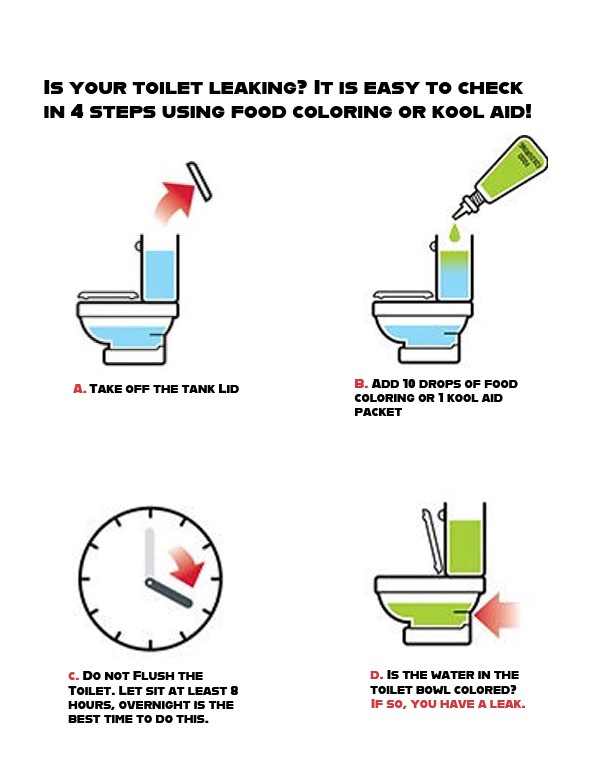Water Leaks
Water Leaks: What You Should Know
Sometimes, customers may have a leak in their plumbing. Here’s how to check for a leak, report one, and learn about common leaks in your home.
How to Report a Leak
If you see or suspect a water leak, please call the Public Works office.
If it’s after hours, call (618) 242-2131.
How to Check for Leaks
Leaks can waste a lot of water. In fact, most homes lose about 10,000 gallons of water every year from small leaks!
Some homes lose even more—up to 90 gallons or more each day.
Common leaks include:
- Dripping faucets
- Worn toilet flappers
- Leaky valves
These are often easy to fix with just a few tools or parts. Fixing these small leaks can save you about 10% on your water bill.
Toilet Leaks
Toilets are one of the most common places for water leaks. If you hear water running after the tank has finished filling, or if water keeps moving into the bowl, your toilet might be leaking.
How to Check for a Leak
Most toilet leaks happen around the parts inside the tank, like the overflow pipe or the rubber flapper (also called a plunger ball). Here’s how to check:
- Take off the lid of the toilet tank and flush the toilet.
- After the tank fills up, look at the water level. It should stop about half an inch below the top of the overflow pipe.
- If the water keeps rising, try adjusting the float or the screw near the float so it shuts off the water at the right level.
Silent Leaks
Sometimes, leaks don’t make any noise. Here’s an easy test to check for a silent leak:
- Put a few drops of food coloring in the tank once it's full.
- Do not flush for at least an hour.
- If the colored water shows up in the bowl without flushing, you have a leak.
Fixing the Problem
Most toilet leaks are caused by a worn-out flapper valve or plunger ball. These parts are usually easy and cheap to replace. You can find what you need at a local hardware or home improvement store.

Faucet Leaks
The next place to check for leaks is your sink and bathtub faucets.
Old or worn-out parts, like rubber washers or gaskets, are common causes of leaks. Even a small drip—just one drop every second—can waste over 3,000 gallons of water each year!
To fix it:
- Try replacing the rubber washer or O-ring inside the faucet.
- Don’t forget to check outdoor faucets too. Make sure the valve closes all the way.
Showerhead Leaks
A leaky showerhead that drips 10 times per minute can waste over 500 gallons of water each year.
To fix it:
- Make sure the showerhead is screwed on tightly.
- Wrap some pipe tape (also called Teflon tape) around the threads before putting the showerhead back on. This helps stop leaks and is easy to do. You can find pipe tape at most hardware stores.
Still Have a Leak?
If you checked your toilets, faucets, and showerheads and still think you have a leak, your next step is to look at:
- Pipes and connections under your sinks
- Water lines and valves in your basement or crawlspace
Sometimes leaks can be harder to spot and might need a closer look.
Contact Information
Public Works Office
1201 Casey Avenue
Mount Vernon IL 62864
See on map: Google Maps
Office Hours
Monday - Friday
7 a.m. - 3 p.m.
Phone: (618) 242-6853
Fax: (618) 242-6861
After Hours/Emergency
(618) 242-2131
Public Works Director
Matt Fauss
Email: matt.fauss@mtvernon.com
Assistant Public Works Director
Stephen Talley
Email: stephen.talley@mtvernon.com
